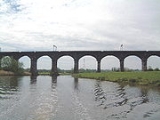
Dutton Viaduct
Encyclopedia
Dutton Viaduct is a railway viaduct
on the West Coast Main Line
where it crosses the River Weaver
and the Weaver Navigation between the villages of Dutton
and Acton Bridge
in Cheshire
, England . It has been designated by English Heritage
as a Grade II* listed building.
It was built during 1836 and was completed on 9 December of that year. It was the longest viaduct on the Grand Junction Railway
(GJR). It is an early example of a major railway viaduct. Its cost was £54,440
(£ as of ). The engineers were Joseph Locke
and George Stephenson
. The contractor was William Mackenzie
. It was the first project for which Thomas Brassey
submitted a tender but Mackenzie's estimate was £5,000 lower. It is built in red sandstone
and has 20 arches. The base of the viaduct pillars are splayed to give greater stability and 700000 cubic feet (19,821.8 m³) of stone was used in its construction. The first GJR trains to carry passengers across the viaduct were run on 4 July 1837. Steel masts were added in the 1960s for electrification. The viaduct is 60 feet (18 m) high and 500 yards (457 m) long.
Viaduct
A viaduct is a bridge composed of several small spans. The term viaduct is derived from the Latin via for road and ducere to lead something. However, the Ancient Romans did not use that term per se; it is a modern derivation from an analogy with aqueduct. Like the Roman aqueducts, many early...
on the West Coast Main Line
West Coast Main Line
The West Coast Main Line is the busiest mixed-traffic railway route in Britain, being the country's most important rail backbone in terms of population served. Fast, long-distance inter-city passenger services are provided between London, the West Midlands, the North West, North Wales and the...
where it crosses the River Weaver
River Weaver
The River Weaver is a river, navigable in its lower reaches, running in a curving route anti-clockwise across west Cheshire, northern England. Improvements to the river to make it navigable were authorised in 1720 and the work, which included eleven locks, was completed in 1732...
and the Weaver Navigation between the villages of Dutton
Dutton, Cheshire
thumb|right|200px|Map of civil parish of Dutton within the former borough of Vale RoyalDutton is a civil parish and village within the unitary authority of Cheshire West and Chester in the ceremonial county of Cheshire, England. It is located approximately east of Runcorn.-External links:...
and Acton Bridge
Acton Bridge
right|thumb|Map of the civil parish of Acton Bridge within the former borough of Vale RoyalActon Bridge is a village and civil parish in Cheshire, England. Located within the unitary authority of Cheshire West and Chester on the River Weaver, it is near the Trent and Mersey Canal at approximately...
in Cheshire
Cheshire
Cheshire is a ceremonial county in North West England. Cheshire's county town is the city of Chester, although its largest town is Warrington. Other major towns include Widnes, Congleton, Crewe, Ellesmere Port, Runcorn, Macclesfield, Winsford, Northwich, and Wilmslow...
, England . It has been designated by English Heritage
English Heritage
English Heritage . is an executive non-departmental public body of the British Government sponsored by the Department for Culture, Media and Sport...
as a Grade II* listed building.
It was built during 1836 and was completed on 9 December of that year. It was the longest viaduct on the Grand Junction Railway
Grand Junction Railway
The Grand Junction Railway was an early railway company in the United Kingdom, which existed between 1833 and 1846 when it was merged into the London and North Western Railway...
(GJR). It is an early example of a major railway viaduct. Its cost was £54,440
(£ as of ). The engineers were Joseph Locke
Joseph Locke
Joseph Locke was a notable English civil engineer of the 19th century, particularly associated with railway projects...
and George Stephenson
George Stephenson
George Stephenson was an English civil engineer and mechanical engineer who built the first public railway line in the world to use steam locomotives...
. The contractor was William Mackenzie
William Mackenzie (contractor)
William Mackenzie was a British civil engineer and civil engineering contractor who was one of the leading European contractors in the 1840s.-Early life:...
. It was the first project for which Thomas Brassey
Thomas Brassey
Thomas Brassey was an English civil engineering contractor and manufacturer of building materials who was responsible for building much of the world's railways in the 19th century. By 1847, he had built about one-third of the railways in Britain, and by time of his death in 1870 he had built one...
submitted a tender but Mackenzie's estimate was £5,000 lower. It is built in red sandstone
Sandstone
Sandstone is a sedimentary rock composed mainly of sand-sized minerals or rock grains.Most sandstone is composed of quartz and/or feldspar because these are the most common minerals in the Earth's crust. Like sand, sandstone may be any colour, but the most common colours are tan, brown, yellow,...
and has 20 arches. The base of the viaduct pillars are splayed to give greater stability and 700000 cubic feet (19,821.8 m³) of stone was used in its construction. The first GJR trains to carry passengers across the viaduct were run on 4 July 1837. Steel masts were added in the 1960s for electrification. The viaduct is 60 feet (18 m) high and 500 yards (457 m) long.

